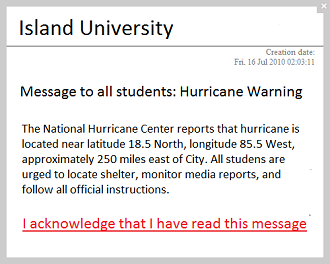There are times that untoward incidents, calamities and emergencies simply cannot be prevented in the workplace. These unfortunate events can disrupt work, cause harm or injury to employees or clients, and can result in the damage of facilities, equipment and materials. What is extremely important is that employers and managers make sure that aside from having an emergency alerts system in place, staff members are able to respond immediately and effectively through proper training and practice.

The following are the most common emergencies in a workplace and how staff members can effectively respond to them should they occur:
Fire
Should you feel that it is required, invite a firefighter or fire department representative to identify the hazards in your workplace and to discuss with your employees how to respond to fires. Remember that the by-products of fire such as smoke and gases can certainly kill. The most effective way to respond to fire that is out of control is to have an emergency alerts system in place and to have a quick an orderly evacuation of the building.
What you should do:
- Pull the fire alarm or set off your emergency alerts
- Call 911.
- Do not use elevators when evacuating. Evacuate quickly and in an orderly fashion.
- Only allow trained responders to use fire extinguishers, or other employees that have been trained to use them properly.
Earthquake
When earthquakes occur, people in the workplace are at risk from getting injured and harmed by windows and ceilings that collapse, and falling objects.
What you should do:
- If you are indoors, stay indoors.
- Either brace yourself against an inside wall or take cover underneath furniture that is sturdy.
- Stay away from falling objects and protect your neck and head.
- Do not use elevators if you need to leave the building. Use the stairways instead.
- Be prepared to help and rescue others if responders are not able to arrive right away.
- Medical emergency
This is the most likely emergency to occur in the workplace. Serious incidents and emergencies such as cardia arrest requires quick and immediate responses. It is extremely vital that medical first responders are adept at first aid and CPR.
What you should do:
- Call 911.
- Do not move the victim not unless it is necessary.
- Do emergency first aid or CPR if you know how, or call on someone who is trained.
- Assist responders when they arrive, and inform them of everything that occurred.
- Find the victim’s personnel file and make sure that his or her contacts are informed about the emergency.
Weather-related emergency
Weather-related emergencies in the workplace are usually caused by blizzards, floods, hurricanes and tornadoes. It is, therefore, important that people are informed of these occurrences through emergency alerts and that employees know how to respond quickly and effectively.
What you should do:
- Wait for instructions from your manager or from the one tasked with relaying information.
- Do not evacuate your workplace unless you are told to do so.
Bomb threats
While some people joke about bomb threats, all threats should be taken seriously.
What you should do:
- Do not use fire alarms or phones in the workplace as they can trigger the bomb to explode.
- Should you find a package which may contain a bomb, take note of the size, shape, sounds and tell responders about the said details.
- Evacuate the building and stay as far away from it as possible.
- Call 911 from outside the building to make sure that radio signals do not set off the bomb should there be any.







